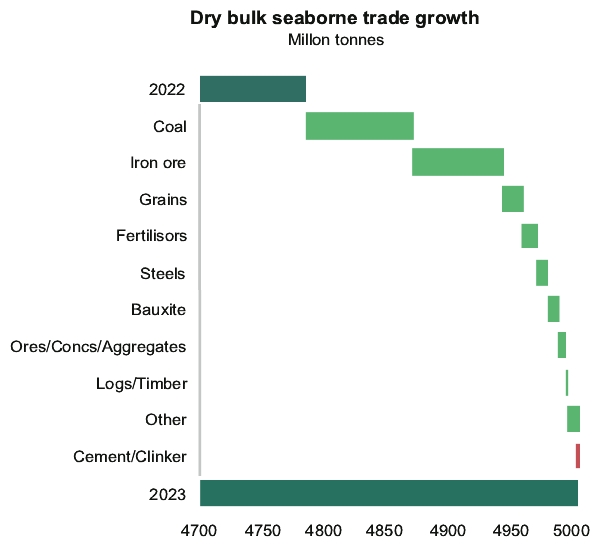Set forth below are brief descriptions of some of the types of charters under which our vessels may be employed.
Time Charter. A time charter is a contract to charter a vessel for a fixed period of time. Typically, under time charter arrangements, the charterer pays a charter hire in regular intervals based on a daily rate and will be responsible for substantially all voyage expenses, such as port, canal and bunker fuel costs, and any other expenses related to the cargoes. The owner of the vessel remains responsible for vessel operating expenses, such as costs for crewing, provisions, stores, lubricants, insurance, maintenance and repairs, as well as costs for drydocking, intermediate and special surveys.
Spot Voyage or Single Voyage Charter. A single or spot voyage charter is a contract to carry a specific amount and type of cargo from a load port(s) to a discharge port(s). Typically, the charterer pays an agreed upon lumpsum amount, and the owner bears substantially all vessel operating expenses and voyage expenses.
Trip Charter. A trip charter is effectively a combination of a time charter and a spot voyage, whereby the charterer hires the vessel for the duration of one voyage. Similar to a time charter, the charterer pays a charter hire in regular intervals based on a daily rate and will be responsible for substantially all voyage expenses. The owner of the vessel remains responsible for vessel operating expenses.
Management of our Company and our Fleet
Overall responsibility for the management of Icon Energy rests with our Board of Directors. Our Board of Directors has organized the provision of management services through Pavimar, a ship management company controlled by our Chairwoman and Chief Executive Officer, Mrs. Ismini Panagiotidi, under the terms of the New Management Agreement which became effective on January 18, 2024. Pavimar operates on the same principles and draw upon the expertise of Pavimar S.A., an integrated vessel commercial and technical manager, also controlled by our Chairwoman and Chief Executive Officer. Founded in 2014, Pavimar S.A. has successfully managed over 50 vessels across the dry bulk, tanker and container sectors, has built a reputation for reliability, and is well-established and regarded within the international shipping community.
Pavimar provides us with vessel commercial and technical management services including, but not limited to, securing employment, post-fixture support, handling vessel sale and purchases, arranging and supervising crew, repairs and maintenance, insurance, provisions, bunkering, day to day vessel operations, and ancillary services. Prior to the effectiveness of our New Management Agreement, vessel commercial and technical management services, including, but not limited to, post-fixture support, arranging and supervising crew, repairs and maintenance, insurance, provisions, bunkering, day to day vessel operations, and ancillary services, were provided to us by Pavimar S.A.
Our Competitive Strengths
We believe that our experienced team, efficient vessel operations and broad industry relationships offer us a competitive advantage in seizing opportunities and navigating industry challenges.
Experienced Executive Management Team. Our executive management team has extensive experience in the shipping industry, bringing a wealth of expertise in all aspects of commercial, technical, operational and financial areas of our business. Our management team is led by Mrs. Panagiotidi, our Chairwoman and Chief Executive Officer, who has over 17 years of experience with operating, owning, and investing in vessels across the dry bulk, tanker and container sectors. In 2014, Mrs. Panagiotidi founded Pavimar S.A. and led it to be the reputable, integrated, commercial and technical vessel manager that it is today, demonstrating her significant leadership and industry experience that we believe will help us drive our success and accomplish our goals.
Efficient Vessel Operations. We intend to capitalize on the accumulated experience and long-standing relationships of Pavimar. Pavimar will operate on the same principles and draw upon the expertise of Pavimar S.A., which has successfully managed over 50 vessels across the dry bulk, tanker and container sectors, has built a reputation for reliability, and is well-established and regarded within the international shipping community. We expect Pavimar will afford us economies of scale, promote the efficient, safe and environmentally responsible operation of our vessels, support our commitment to regulatory compliance, ensure recruitment and retention of skilled seafarers, and help us achieve operational excellence.
Broad Industry Relationships. We believe our management team’s competencies and breadth of experiences, coupled with Pavimar’s deep industry knowledge and global network, provide us with access to high quality charterers, financial institutions, and other seaborne transportation industry participants. We plan to leverage these relationships in successfully competing for new charters, profitably operating our fleet, identifying attractive investment opportunities, and sourcing capital to fuel our growth.



